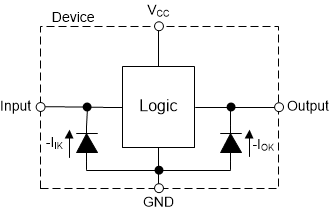JAJSRJ5A October 2023 – April 2024 SN74LVC2G100-Q1
PRODUCTION DATA
7.3.3 Clamp Diode Structure
Figure 7-1 shows the inputs and outputs to this device have negative clamping diodes only.
CAUTION: Voltages beyond the
values specified in the Absolute Maximum Ratings table can cause damage to
the device. The input and output voltage ratings may be exceeded if the input and
output clamp-current ratings are observed.
 Figure 7-1 Electrical Placement of
Clamping Diodes for Each Input and Output
Figure 7-1 Electrical Placement of
Clamping Diodes for Each Input and Output